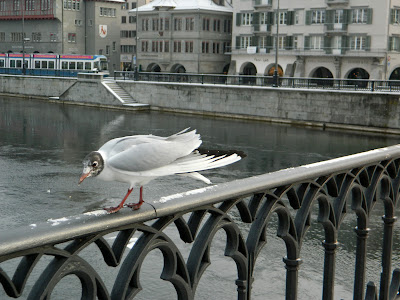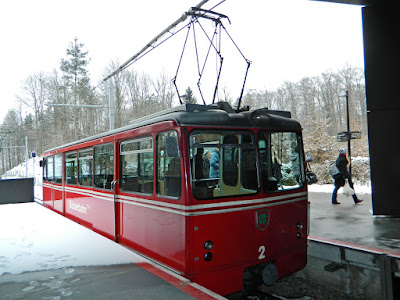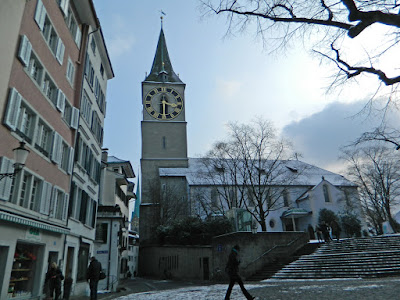A cold gloomy day as we left Shanghai for Europe where Kent had business. Arrived in cold gloomy Zürich, Switzerland and caught the shuttle van to the Park Inn by Radisson Hotel near the airport.
They do have a colorful mascot:
A round shower in the "middle" of the room:
Sunday, February 24, 2013
We had a free day to explore Zürich, the largest city in Switzerland. A ten-minute walk brought us to the local train station to catch the S5 into the city. Arrived at the Hauptbahnhof/Main railway station (1871):
Yes, there is snow on the ground and the fountain is frozen.
We took a tram up Bahnhofstrasse to Paradeplatz:
It was too early to stop in the Sprüngli Confectionary, opened here in 1859:
Sprüngli is known for some wonderful chocolate truffles. But the shop windows only showcased other candies and these cakes:
Münsterplatz:
Zunfthaus zur Waag/Guild House of the Scales (c1315):
Formerly the guild of linen and wool weavers, and milliners.
Schirmfabrik/Umbrella Factory:
Zunfthaus zur Meisen/Guild House of Meisen:
Formerly the guild of wine merchants, saddle makers, and painters, now a porcelain museum.
A water fountain for people and dogs:
The main feature of Münsterplatz is the Fraumünster/Church of Our Lady (rebuilt 1250):
Above is the view of the clock tower and the 9m/30' stained glass window (1940) by Augusto Giacometti.
Below is a view of of the choir where there are five stained glass windows (installed 1970) by Marc Chagall:
(No photos allowed inside.)
Stadthaus/City Reception Hall (1884):
View across the Limmat River at the Wasserkirche and the spires of Grossmünster:
Chinese tourists feeding the gulls:
Chroicocephalus ridibundus/Black-headed Gull:
West bank of the Limmat River:
Love locks on the Münsterbrücke/Church Bridge:
Grossmünster/Great Church (inaugurated 1220) spires:
In the south tower above, sits Charlemagne.
On the north tower, there is Heinrich Bullinger:
Bullinger was successor to Ulrich Zwingli who initiated the Swiss-German Reformation from the Grossmünster.
Bronze doors (1935) by Otto Münch:
Kirchegasse/Church Lane, typical street in the old town:
Fountain at Untere Zäune:
Results of a poster campaign for World Water Day 2012:
Tamiko with a fake snowman:
It was near the Kunsthaus/Art Gallery (1910):
Sculpture “Porte de l’Enfer/Gate of Hell” (1880-1917) by Auguste Rodin:
A tram took us from the Kunsthaus to Römerhofplatz where we caught the Dolderbahn:
This rack railway climbed the Adlisberg hill to the Dolder Grand Hotel (1899):
Listed in the 1,000 Places to See Before You Die.
We had a light lunch in the lobby where tea is served in the afternoon:
Tamiko in the atrium with a unique pendulum clock:
A misty view of the city from the Dolder Hotel:
I don't know who designed the original health spa, but a major renovation was led by Norman Foster for its reopening in 2008:
Kent with one of the sculptures on the property:
Back on the Dolderbahn to descend the hill:
Another tram to the Opera (1891):
Yet another tram down along the shore of the lake to see the Le Corbusier Center (1967):
This was the last building designed by architect Le Corbusier (born Charles-Édouard Jeanneret) and was meant to showcase his work, although it appeared empty.
Swiss public toilets (to contrast with Chinese public toilets!):
Returned to the old town by tram.
Wasserkirche/Water Church (reconstructed 1486):
The statue is of reformer Ulrich Zwingli.
Zunfthaus zur Zimmerleuten/Guild House of Carpenters:
Zunfhaus zur Rüden/Guild House of Nobility:
Along the Limmat River:
(Chroicocephalus philadelphia/Bonaparte's Gull)
Zunfthaus zur Kambel/former Zunfthaus zur Haue/Guild House of the Axe:
Former guild for wine and food merchants, later salt merchants.
Oriel window with salt merchant coats of arms:
Zunfthaus zur Schmiden/Guild House of Smiths:
Former guild for blacksmiths, gold and silversmiths, clockmakers, and physicians.
Wrought-iron sign:
The Cabaret Voltaire:
Home of the art movement of Dadaism.
A bust of Lenin in a shop window on Spiegelgasse:
It is said that Lenin lived on Spiegelgasse in 1917.
Filming on Spiegelgasse:
Note the rain:
A shutter holder:
Neumarkt/New Market fountain:
Zunfthaus zur Schuhmachern/Guild House of Shoemakers:
Interesting candle sconces:
Stüssihiofstatt fountain:
Rathaus/City Hall:
Wild store facade:
Painted doorway ceiling:
St. Peter's Church:
With the largest church clock face in Europe.
View from Lindenhof, site of a former Roman castle:
Lindenhof fountain:
Back on Bahnhofstrasse, a Jugendstil doorway:
Took another tram along the Sihl River to the Helvetia Hotel:
Listed in the 1,000 Places to See Before You Die.
The stairs were supposed to feature art by Philippe Decreuzat:
The restaurant also displayed works of art, but no longer art from the Zürich Concrete Movement:
From the Helvetia Hotel, we followed the Schanzengraben, a canal:
Mergus merganser/Goosanders:
A men's bath/pool located right on the canal:
What's this?
A goal for canoe or kayak polo!
The entire "field:"
Boats in the canal as we approach the lake:
Lake Zürich:
We crossed the Quaibrücke/Quay Bridge over the Limmat River to reach Kronenhalle:
This restaurant is also listed in the 1,000 Places to See Before You Die.
The restaurant as it is known today was established in 1925 by Hulda & Gottlieb Zumsteg.
There are many paintings allegedly by famous artists; farther along this wall you can see the "legendary" portrait of Madame Zumsteg by Varlin (born Willy Guggenheim):
We may not have known our painters, but we knew our food!
Kronenhalle Geschnetzeltes/Sliced veal in cream sauce with Rösti/Potato pancake:
Kalbfleisch Wurst/Veal sausage, also with Rösti/Potato pancake:
A perfect ending for a day in Switzerland!





















































































No comments:
Post a Comment